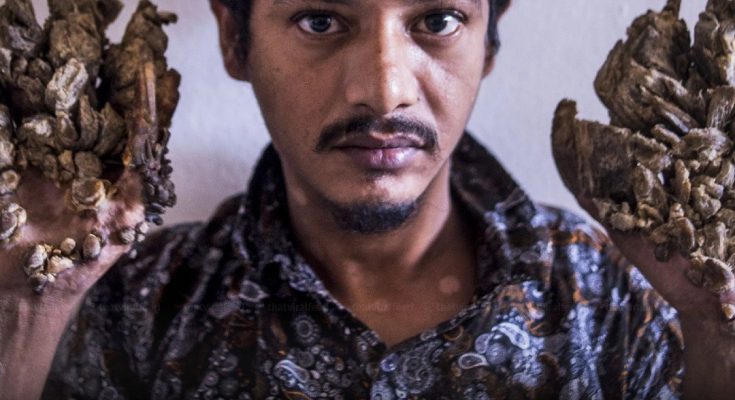Abul Bajandar has epidermodysplasia verruciformis — a genetic disorder so uncommon that fewer than ten cases have been documented anywhere in the world.
This illness causes huge wart-like growths, similar in texture to tree bark, to sprout from his fingers, toes, arms, and legs. With no cure available, Bajandar is trapped in a heartbreaking cycle. Surgeries give him temporary relief, but the growths always return — larger and stronger — making even simple tasks like walking or holding everyday objects incredibly hard.

Between 2016 and 2018, he went through multiple surgeries that successfully removed almost 6kg (13lb) of the wart tissue. This gave him a short window of normalcy, where he could use his hands and feet without pain.
For the first time since he was a teenager, he could walk without agony and hold his daughter in his arms. “To feel her skin made me the happiest father in the world,” he recalled with emotion.
“After a couple of months, the warts began to grow again.” Bajandar said. “I was completely aware that it is a genetic disease and that it has no cure.”
He went on to add: “But I always hoped it wouldn’t reappear and I never thought it would strike again so soon and with greater virulence.”

“Although we tie them with a thread to prevent them from growing and spreading open, there is no way to contain the disease.” said his wife, Halima Khatun.
“As if that weren’t enough, I constantly get infected wounds, the pain is unbearable.” Bajandar confessed, explaining that he can’t get through the day without antibiotics and painkillers. “I need higher doses every time and they cost a lot of money.”
“I have to soak my hands and feet in hot water for a long time to soften them, and even then I feel a lot of pain.” Bajandar explained. “I don’t rule out doing something crazy one day.”
These days, his life is mostly confined to two places — lying in bed with his phone, which still works with his wart-covered hands, or sitting outside on his plastic porch chair when the heat inside becomes too much to bear.



